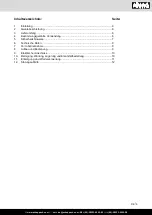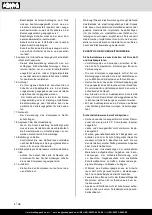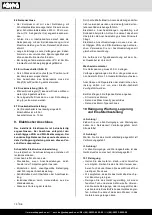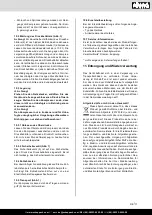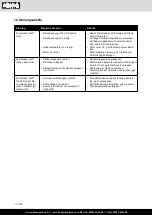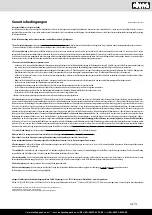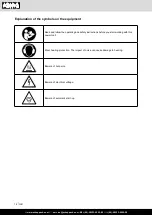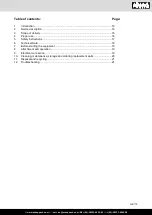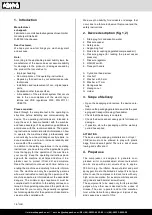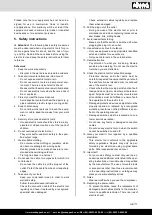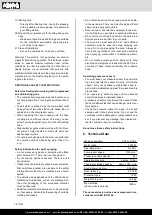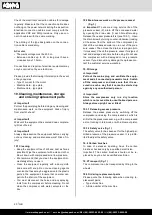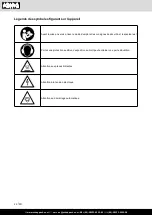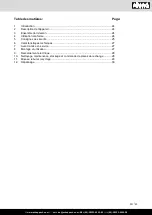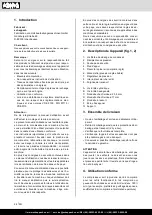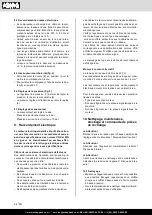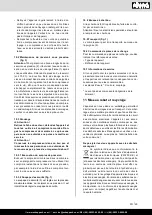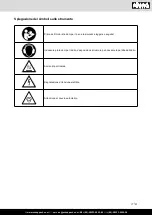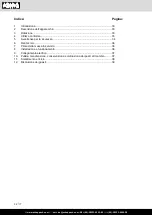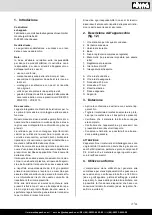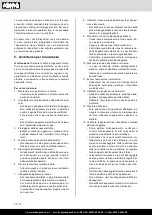
www.scheppach.com /
service@scheppach.com /
+(49)-08223-4002-99 /
+(49)-08223-4002-58
GB | 19
Wear hearing protection.
The effects of noise can cause a loss of hearing.
7. Before starting the equipment
• Before you connect the equipment to the mains
supply make sure that the data on the rating plate
are identical to the mains data.
• Check the equipment for damage which may have
occurred in transit. Report any damage immedi-
ately to the transport company which was used to
deliver the compressor.
• Install the compressor near the point of consump-
tion.
• Avoid long air lines and supply lines (extension ca-
bles).
• Make sure that the intake air is dry and dust-free.
• Do not install the compressor in a damp or wet
room.
• The compressor may only be used in suitable
rooms (with good ventilation and an ambient tem-
perature from +5 °C to 40 °C). There must be no
dust, acids, vapours, explosive gases or inflamma
-
ble gases in the room.
• The compressor is designed to be used in dry
rooms. It is prohibited to use the compressor in ar-
eas where work is conducted with sprayed water.
8. Attachment and operation
m
Important!
You must fully assemble the appliance before
using it for the first time!
You will require the following tools for assembly and
installation:
2x open-ended wrench size 14 mm, 1x Allen key
5 mm (not included)
8.1 Fitting the Transport handle (fig. 5)
• Put the transport handle (9) into the holder at the
pressure vessel (2) and fix it with the 4 cylindrical
head screws (A). Fix the cylindrical head screws
(A) with a Allen key (5 mm).
8.2 Fitting the supporting foot (fig. 6 / 6.1
)
• Mount the enclosed supporting foot (4) with the two
hex bolts (B), the washers ø 23.5 mm (C) the wash-
ers ø 17 mm, the spring washers (D) and the nuts
(F), as shown in Figure 6 and 6.1.
8.3 Fitting the holding (fig. 7)
• Screw the holder 2 (G) in the threaded holes on the
right and left of the transport handle (9), and secure
the holder with the nuts against twisting.
8.4 Mains connection
• The compressor is equipped with a mains cable
with shock-proof plug. This can be connected to
any 230 V~ 50 Hz shock-proof socket which is pro-
tected by a 16 A fuse.
• Before you use the machine, make sure that the
mains voltage is the same as the operating voltage
(see the rating plate).
• Long supply cables, extensions, cable reels, etc.,
cause a drop in voltage and can impede motor
start-up.
• At low temperatures below +5 °C, sluggishness
may make starting difficult or impossible.
8.5 ON/OFF switch (fig. 2)
• To switch on the compressor, press the button (8)
on position I.
•
To switch off the compressor, press the button (8)
on position 0.
8.6 Setting the pressure (fig. 2)
• You can adjust the pressure on the pressure gauge
(6) using the pressure regulator (7).
• The set pressure can be taken from the quick lock
coupling (5).
8.7 Setting the pressure switch
• The pressure switch is set at the factory.
Cut-in pressure approx. 8 bar.
Cut-out pressure approx. 10 bar.
9. Electrical connection
The electrical motor installed is connected and
ready for operation. The connection complies
with the applicable VDE and DIN provisions.
The customer‘s mains connection as well as
the extension cable used must also comply with
these regulations.
Damaged electrical connection cable
The insulation on electrical connection cables is of-
ten damaged.
This may have the following causes:
• Passage points, where connection cables are
passed through windows or doors.
• Kinks where the connection cable has been im-
properly fastened or routed.
• Places where the connection cables have been cut
due to being driven over.
• Insulation damage due to being ripped out of the
wall outlet.
• Cracks due to the insulation ageing.
Such damaged electrical connection cables must not
be used and are life-threatening due to the insula-
tion damage.

